|
Sunday, November 29, 2009
Are over-leveraged counties seeing an increase in food stamp usage?
posted by
Razib @ 11/29/2009 11:33:00 AM
Since The New York Times put up the csv file which they used to generate their maps of food stamp usage, I thought I'd look at the data a little closer. In particular, look at this graphic of change in food stamp usage by county (dark equals more usage):
 I was curious about this part from the story below:: While use is greatest where poverty runs deep, the growth has been especially swift in once-prosperous places hit by the housing bust. There are about 50 small counties and a dozen sizable ones where the rolls have doubled in the last two years. In another 205 counties, they have risen by at least two-thirds. These places with soaring rolls include populous Riverside County, Calif., most of greater Phoenix and Las Vegas, a ring of affluent Atlanta suburbs, and a 150-mile stretch of southwest Florida from Bradenton to the Everglades. Thanks to the Census I happen to have 2007 housing value and household income data. Also though it would be interesting to compare with obesity and diabetes rates. Scatterplots & correlations (r) below. 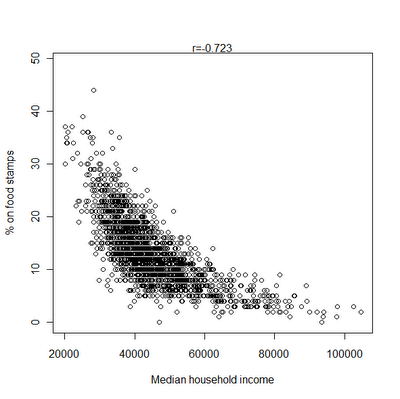 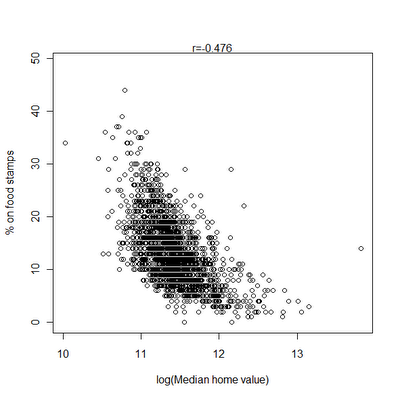 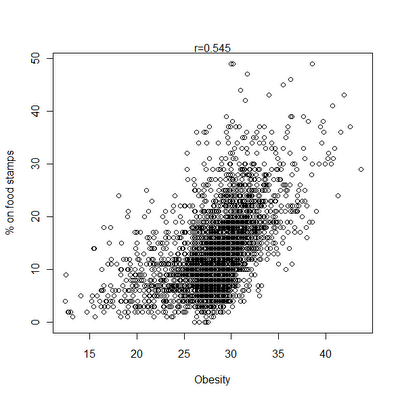 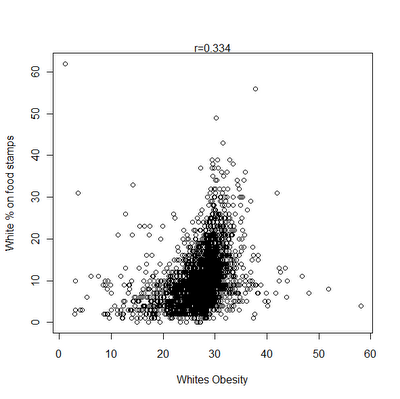  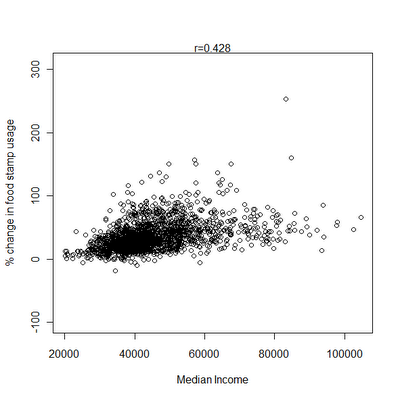  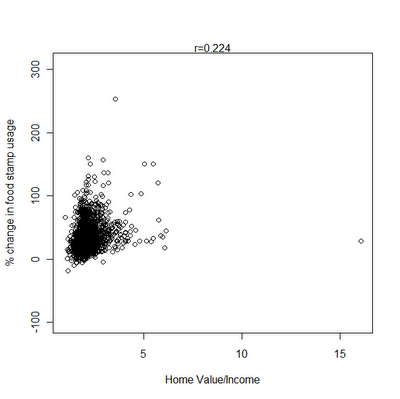 It does indeed seem that food stamp usage has been increasing in higher income and property value counties. The Census data I used above were collected between 2005-2007, during the height of the late great property bubble. But when I took the ratio of property value by income as a rough proxy for being over-leveraged it didn't seem to add much. When I took the partial correlation of home value and increase in food stamp usage controlling for income, it was only 0.11. Here are some other correlations controlling for income: % on food stamps - obesity = 0.33 % on food stamps - diabetes = 0.44 % of whites on food stamps - white diabetes rates = 0.36 % of whites on food stamps - white obesity rates = -0.05 There's an obvious correlation between black proportion in a county and food stamp utilization. r = 0.43. So using proportion of blacks as a control: % on food stamps - obesity = 0.43 % on food stamps - diabetes = 0.51 % on food stamps - white diabetes rates = 0.43 % on food stamps - white obesity rates = 0.06 % on food stamps - median household income = -0.71 It does seem to be correct though that food stamp utilization has been shooting up in more affluent communities. But if it is true that well over 90% of those eligible in places like Missouri are already using food stamps, while only 50% of those eligible in California are, it makes a bit more sense. In wealthier communities likely more people go in and out of eligibility and so never need to make recourse. In contrast, in regions where people are immobile and poverty is chronic there isn't as much scope to increase the program because most people who are eligible are already on it. That probably explains the triangular geometry of the scatterplot, very low on the affluence latter social services seem to have soaked up all eligible individuals, leaving little room for increase with the recession. Note: Estimates are white obesity are based on state level variation. Estimates of white diabetes rates are based on national level variation. These two variables need to be appropriately down-weighted in terms of confidence of their accuracy, especially the second. Update: By coincidence, a reader noted this similarity of maps this morning: 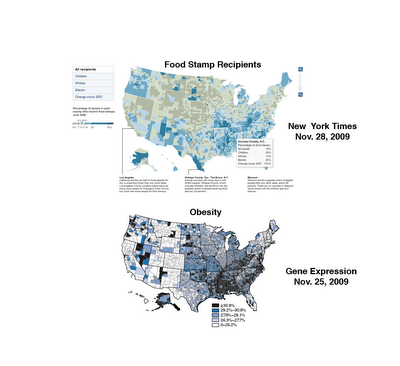 Labels: data, Diabetes, Food stamps, Obesity
Friday, November 27, 2009
Update: I made a major error in the algebra of estimating "white diabetes rates" per county. So the last set of correlations was junk. I think fixed the issue. Thanks to "bayesian" who noted that something was off with them.
The CDC provides data on diabetes by county as well as obesity. Some Correlations: Diabetes-Obesity = 0.72 Diabetes-Black = 0.65 Diabetes-Latino = -0.14 What's going on with the last? Latinos, in particular Mexican Americans, are more susceptible to diabetes than whites. So it must be that in counties where there are many Mexican Americans, white have particularly low prevalence of diabetes. Other correlations: Diabetes-Obama Vote = -0.01 Diabetes-College Educated = -0.46 Diabetes-Median Household Income = -0.45 Diabetes-Median Home Value = -0.42 I'm struck by the fact that the correlations are higher than for obesity (if you think about it in terms of r-squared, the square of the correlation explaining the variance of Y by X, it's even more striking). Probably has to do with the fact that only a subset of the obese are diabetic, as diabetes is a more extreme manifestation of morbidity. Let's control for the % black in a county with partial correlations: Diabetes-Obesity = 0.63 Diabetes-Obama Vote = -0.28 Diabetes-College Educated = -0.52 Diabetes-Median Household Income = -0.41 Diabetes-Median Home Value = -0.43 Not much change in the correlations really. Also, now there is a modest correlation between political liberalism and lower levels of diabetes now that the black proportion is controlled (the correlation with black proportion controlled for obesity and Obama vote is -0.24, same magnitude and direction). I also tried to estimate white diabetes prevalence by county. The national data suggest that blacks are 1.7 times more likely to be diabetic, and Latinos 2 times more likely. Obviously there's going to be some variance for these two groups, so I don't know how useful this estimate for whites is going to be. But, it should put into stark relief the negative correlation between the proportion of Latinos and white diabetic rates (note: again, Latinos seem to vary quite a bit and there are many counties along the Mexican-American border, as well as on the East Coast, where Latinos are so far deviated from the aggregate risk that I had to dump the data). Here are some correlations (again, white county proportions are estimates): White diabetic proportion-White obesity rate (estimate from previous post) = 0.47 White diabetic proportion-College Educated = -0.46 White diabetic proportion-Obama Vote = -0.18 White diabetic proportion-Median Household Income = -0.39 White diabetic proportion-Median Home Value = -0.44 OK, enough with correlations. Maps. Diabetes for all groups:  Now, my estimates for whites: 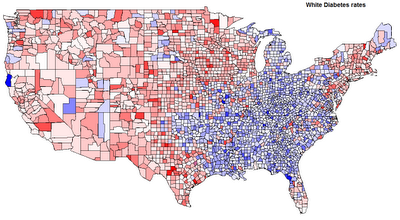 I think the assumption of an invariant relationship between white and non-white rates (i.e., blacks = 1.7 X whites) is causing problems. The white areas underneath the median suspiciously concentrated in the Black Belt. So let's just focus on counties which are 85% or more white:  Labels: Diabetes
Thursday, February 15, 2007
Keeping with the diabetes theme, the first genome-wide association study of Type II diabetes has been published, and it's extraordinarily promising. Besides picking up the oft-replicated TCF7L2 gene mentioned before, they pick up three other loci, including finding a non-synonymous mutations in a zinc transporter. That's notable because 1. non-synonymous mutations clearly can have phenotypic effects (there's no wondering, could this really do something?), and 2. drug targeting of zinc transport is feasible (TCF7L2 is a transcription factor, and when you start playing with transcription factors you risk messing with a lot of pathways). The news article accompanying this study has some good perspective:
In 1918, Ronald Aylmer Fisher, an evolutionary biologist and pioneer of modern statistics, published a paper on the genetic causes of disease that brought together two rival factions. Geneticists promoted a paradigm in which diseases worked a lot like Mendel's pea plants, with just one or two genes responsible for each condition. Biometricians, however, advocated a continuous distribution of phenotypes. Fisher suggested that many mendelian traits could result in the continuous distribution of a disease. In doing so, he established the conceptual basis for the search for complex disease genes that continues today. Labels: Association, Diabetes, disease, Genetics
Speaking of the thrifty genotype hypothesis, a new paper from the cats at deCODE Genetics takes an in depth look at one of the loci consistently implicated in Type II diabetes. According to the authors, the succeptibility allele is ancestral, and the other, non-ancestral allele shows signs of being under recent positive selection in all the populations studied. Even more interestingly, the protective allele is associated with decreases in levels of circulating ghrelin (a hormone that increases appetite) and increases in levels of circulating leptin (a hormone that decreases appetite). This would seem, by my reckoning, to be consistent with the thrifty genotype hypothesis. In addition,
We obtained rough age estimates for HapA [the protective allele] based on its recombination history: 11,933, 8,401 and 4,051 years for the CEU, East Asian and YRI HapMap groups, respectively. Although tentative, these ages coincide broadly with the onset of agriculture in the three geographic regions represented by the HapMap groups. On the other hand, the succeptibility allele is associated with decreased BMI after controlling for diabetic status, though I'm not sure that has any bearing on the hypothesis. The authors conclude, bizarrely, "we note our findings contradict a key prediction of the thrifty-genotype hypothesis, insofar as HapBT2D, a major risk factor for type 2 diabetes, is negatively associated with BMI and is not the variant that contributed to adaptive evolution in the recent past." Huh? I can only conclude, based on that statement, that the authors aren't really clear on what the thrifty genotype hypothesis is. The original Neel paper (which is cited in this paper, so the authors have hopefully read it) makes a few simple claims, the most important of which is that the "diabetic genotype" was favorable up until the transition from the hunter-gatherer lifestyle to agriculture. It certainly does not claim that a diabetes-causing allele should be under recent positive selection, nor am I sure how anyone could get that impression. I'm inclined to take the exact opposite conclusion from this paper than the authors--that is, this data seems to support, rather than contradict, a key prediction of the thrifty genotype hypothesis, insofar as the ancestral allele leads to succeptibility, and the derived allele, which arose at about the time of agriculture, mat be associated with reduced appetite. Labels: Association, Diabetes, disease, Genetics |



